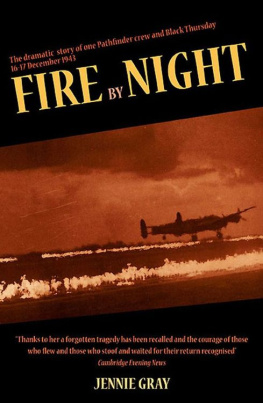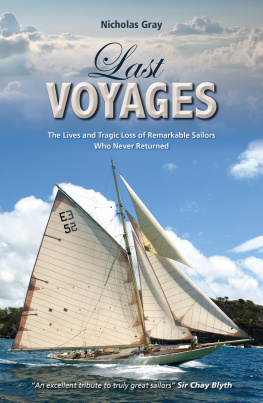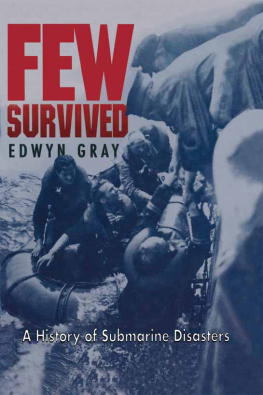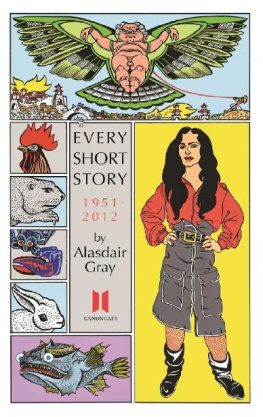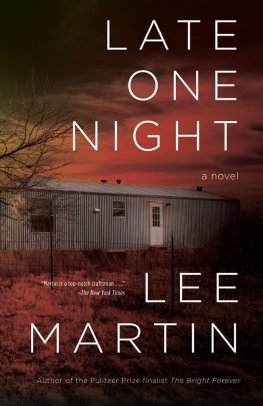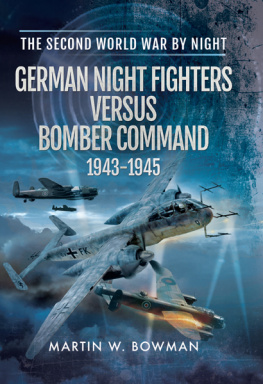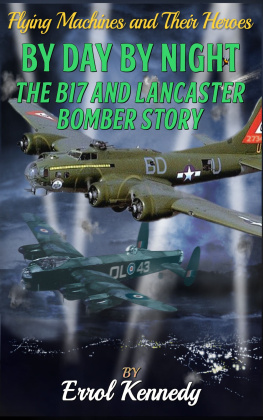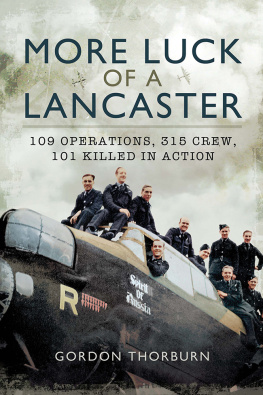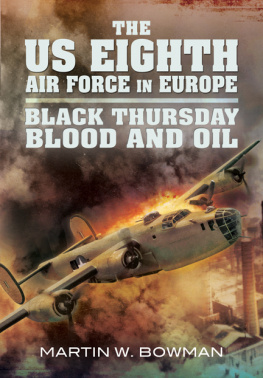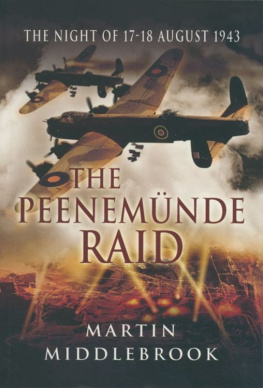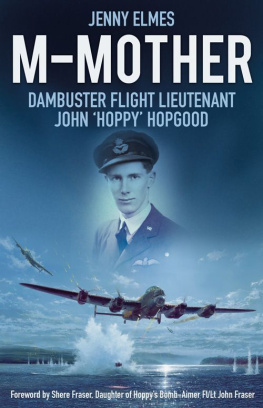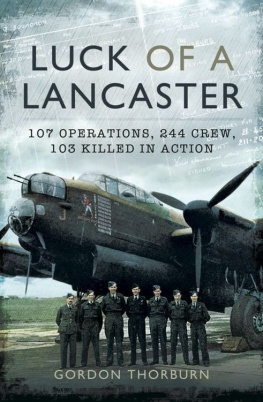
Published by
Grub Street
4 Rainham Close
London, SW11 6SS
First published in hardback in 2000
This edition copyright Grub Street 2011
Text copyright Jennie Gray 2011
British Library Cataloguing in Publication Data
Gray, Jennie.
Fire by night: the dramatic story of one Pathfinder crew and Black Thursday, 16-17 December 1943.
1. Mack, Joe. 2. Great Britain. Royal Air Force. Bomber Command. Group, No.8--History. 3. World War, 1939-1945--Aerial operations, British. 4. Survival after airplane accidents, shipwrecks, etc. 5. Schweinfurt (Germany)--History--Bombardment, 1943.
I. Title
940.5'44'941-dc22
ISBN-13: 9781906502997
Digital Edition ISBN: 9781909166936
All rights reserved. No part of this publication may be reproduced, stored in a retrieval system, or transmitted in any form or by any means electronic, mechanical, photocopying, recording or otherwise, without the prior permission of the copyright owner.
Cover design by Sarah Driver
Formatted by Sarah Driver
Printed and bound by MPG Ltd, Bodmin, Cornwall
Grub Street Publishing only uses
FSC (Forest Stewardship Council) paper for its books.
The cover photograph depicts a Lancaster taking off surrounded by the flames of the FIDO (Fog Investigations Dispersal Operations) installation. A continuous line of burners on each side of the main runway provided sufficient heat to disperse fog for take-off and landing. This was not in operation on the night of 16/17 December. Courtesy The Bombers by Robin Cross.
This book is dedicated to the memory of Ted Thackway, George Grundy, Jack Powell, Tony Lawrence, Sandy Grant, Leslie Laver, & Joe Mack who survived them by 50 years.
Contents
Acknowledgements
First and foremost, my eternal gratitude to Ken Basham, who took me to see the reputed crash site of K-King, and later permitted a detailed investigation with the Lincolnshire Aircraft Recovery Group. I also owe Ken a huge debt of gratitude for collecting and passing on local stories about the crash, and in particular for putting me in touch with Bob Plane, who very sadly died of cancer shortly after I spoke to him.
I would also particularly like to thank Michael Bowyer, the wellknown aviation writer, for putting me in touch with Ken Basham in the first place, and for being the person who first confirmed we really were dealing with the remnants of a 97 Squadron aircraft. Also Dave Stubley and Ian Blackamore of the Lincolnshire Aircraft Recovery Group, for further invaluable help in establishing the true significance of the crash site.
I would like to most sincerely thank the families of Ted Thackway, Leslie Laver, George Grundy, and Tony Lawrence, for so kindly sharing their memories and their photographs, and also Nancy Leeman and Mary Brown who knew Ted very well and who sent me the only surviving photographs of him in the RAF. In addition my thanks are due to Judith Allott, daughter of Agnes Powell, Jacks wife, and to Jack Coates, the brother of William Darby Coates who won the DFM on the night of 16th/17th December 1943.
As for information about RAF Station Bourn and 97 Squadron, my greatest thanks go to Albert East, John Arthurson, Arthur Tindall, and Arthur Spencer (who most kindly also read the entire manuscript at two stages in its development and made several invaluable points). Also Joan Beech, Geoffrey Gilbert, Maurice Hemming, Tiger Billows, Bill Ford, Bob Philips, John Jones, and Percy Smith.
Last but by no means least, Walter Bushby, a former member of the ground crew at Bourn, who also read the manuscript at a critical stage. Walter gave invaluable help in establishing Sidney Matthews living and working conditions at Bourn, and joined happily in all the theorising as to the effect which they may have had upon his actions.
I have received the help of dozens of other people in researching this book, and this list would go on forever if I included everyone. However, I would also very much like to thank the following:
For Invaluable Local Knowledge of Bourn: Cyril Crow, Jim Hansford
Blackpool and W/Ops Training: Frank Munro
FIDO & Black Thursday: Geoffrey Williams, author of Flying Through Fire , a History of FIDO
The Crash of D-Donald on Ingles Farm: Colin Stocker, Don Pawley, and Clair Nutting
Texel Island : Bram van Dijk; Robert Brautigam for his translations and general help and encouragement
Ely Hospital : My uncle, Dr P M McAllen, for all his help with listing and understanding Joes injuries, and for tracing Watson-Joness book. Also Peter Lawler, Tom Williams, Valerie Cornford, Herbert Bailey, Les Mitchum, Leslie Morgan, Jack Reynolds, and many others.
The Leas : Above all, David Page, who worked as a remedial instructor both at Ely and The Leas and was a veritable gold-mine of information and photographs. Also Peter Ray, George Hodgson, Ken Dykes, Norman Scullard, John Gitting, Jim ONeill, Mr and Mrs John Curwood, Mrs Shillcock, and many others.
And lastly The RAF Museum at Hendon and The Imperial War Museum at London and Duxford, in particular Christine Campbell and Mr Eddie West at the latter.
Preface to the New Edition
Bomber Commands first and everlasting enemy the weather...
John Terraine, The Right of the Line
If you are reading Fire By Night for the first time, it is probably best if you save this preface for last because it adds new information to the books central story.
Fire By Night was written over 10 years ago, long before the internet exploded into every area of our lives. The research which I carried out lasted four years, and it took one year and 1,000 to trace five of the families of my fathers crew the crew of K-King. Nowadays this type of research can usually be done in minutes on the internet, and often costs nothing at all. Then it consisted of going through birth, marriage and death certificates, trying to identify the right family and thus trace a way through the generations to modern family addresses. The last and hardest family to find through those old-fashioned methods was that of Jack Powell, the navigator. The fact that his name is so common made it very difficult, and for the same reason I never found the family of Sandy Grant, the Canadian bomb aimer.
Since completing the book, research has become a hundred times easier. If you have a website as I do (www.97Squadron.co.uk), people often get in touch with you rather than you having to laboriously and expensively search for them. It is by this means that, in the last seven to eight years, I have come to know dozens of 97 Squadron aircrew where formerly they were just names in the Operation Record Book. If I was writing this book today, it would create a far more detailed picture of who exactly was at Bourn on the wintery day in 1943 when the crew of K-King arrived at the base. The story of the losses of that November and December would contain many small portraits, and they would include (to suggest but a few): Frank McEgan, a highly talented Australian pilot with a mischievous sense of humour, who had only ever wanted to be an airman; the glamorous and heroic Carlos Manuel Brown, who had been awarded the Croix de Guerre by the Free French; and Tommy Handley, Norman McIntyre, Bob Butler and Fairey Battle, who were in Brills crew and thus had the sad distinction of being the only 97 Squadron crew shot down over Germany on the night of Black Thursday.
I have also found out more about other aircrew described in this book, for example, Peter De Wesselow, whose wife, Rosalind, got in touch with me in 2006. She was able to tell me that her husband, who had died over twenty years before, was a different Peter De Wesselow to the one that not only I but Max Hastings had identified. (Max Hastings drew a pen portrait of De Wesselow in his 1979 book Bomber Command .) The De Wesselow who flew with 97 Squadron on Black Thursday had studied for a while in Freiberg in Germany, which would lead to him once refusing to fly in a bombing raid on that city. Later he studied PPE at New College, Oxford. He transferred to the RAF from coastal defence, probably from Coastal Command. He was a first-class pilot, and a very thoughtful man who left a brief, but totally memorable, description of the bomber boys lot. Speaking of the unreality of life in Bomber Command, he said, You were living in, say, Cambridgeshire or Norfolk: you were thinking of friends, pubs, girls, even intellectual pursuits. Then you were launched for eight hours into a different world at 20,000 feet over Germany. (Quoted in The Devils Tinderbox Dresden 1945, by Alexander McKee.)
Next page
